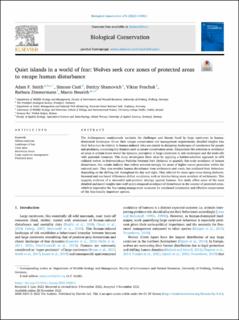| dc.contributor.author | Smith, Adam F. | |
| dc.contributor.author | Ciuti, Simone | |
| dc.contributor.author | Shamovich, Dmitry | |
| dc.contributor.author | Fenchuk, Viktar | |
| dc.contributor.author | Zimmermann, Barbara | |
| dc.contributor.author | Heurich, Marco Dietmar | |
| dc.date.accessioned | 2023-01-16T09:06:41Z | |
| dc.date.available | 2023-01-16T09:06:41Z | |
| dc.date.created | 2023-01-05T13:56:20Z | |
| dc.date.issued | 2022 | |
| dc.identifier.citation | Biological Conservation. 2022, 276 . | en_US |
| dc.identifier.issn | 0006-3207 | |
| dc.identifier.uri | https://hdl.handle.net/11250/3043587 | |
| dc.description | © 2022 The Authors. Published by Elsevier Ltd. This is an open access article under the CC BY license (http://creativecommons.org/licenses/by/4.0/) | en_US |
| dc.description.abstract | The Anthropocene continuously escalates the challenges and threats faced by large carnivores in human-dominated landscapes. Given their unique conservation and management requirements, detailed insights into their behaviour in relation to human-induced risks are crucial to designing landscapes of coexistence for people and predators, containing key features such as nature conservation areas. Adaptations like selection or avoidance of areas at certain times reveal the dynamic perception of large carnivores to risk-landscapes and the trade-offs with potential resources. This study investigates these ideas by applying a habitat-selection approach to GPS collared wolves in Belovezhskaya Pushcha National Park (Belarus) to quantify fine-scale avoidance of human disturbance. Our results indicate that wolves selected strongly for areas of higher nature protection within the national park. They also avoided human disturbance from settlements and roads, but mediated their behaviour depending on the shifting risk throughout the day and night. They selected for more open areas during darkness. Seasonal and sex-based differences shifted avoidance, such as females being more avoidant of settlements. This suggests evidence of a successful anti-predator strategy against humans. Our study offers some of the most detailed and novel insights into wolf spatio-temporal avoidance of disturbance in the context of protected areas, which is imperative for fine-tuning management measures for continued coexistence and effective conservation of this functionally important species. | en_US |
| dc.language.iso | eng | en_US |
| dc.rights | Navngivelse 4.0 Internasjonal | * |
| dc.rights.uri | http://creativecommons.org/licenses/by/4.0/deed.no | * |
| dc.subject | habitat-selection | en_US |
| dc.subject | landscape of fear | en_US |
| dc.subject | Canis lupus | en_US |
| dc.subject | Bialowieza forest | en_US |
| dc.subject | large carnivore management | en_US |
| dc.subject | protected areas | en_US |
| dc.title | Quiet islands in a world of fear: Wolves seek core zones of protected areas to escape human disturbance | en_US |
| dc.type | Peer reviewed | en_US |
| dc.type | Journal article | en_US |
| dc.description.version | publishedVersion | en_US |
| dc.source.pagenumber | 11 | en_US |
| dc.source.volume | 276 | en_US |
| dc.source.journal | Biological Conservation | en_US |
| dc.identifier.doi | 10.1016/j.biocon.2022.109811 | |
| dc.identifier.cristin | 2101376 | |
| dc.source.articlenumber | 109811 | en_US |
| cristin.ispublished | true | |
| cristin.fulltext | original | |
| cristin.qualitycode | 2 | |

